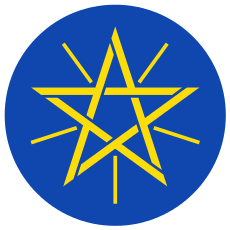Government of Ethiopia
 |
| This article is part of a series on the politics and government of Ethiopia |
|
|
Judiciary
|
The government of Ethiopia is structured in a framework of a federal parliamentary republic, whereby the Prime Minister is the head of government. Executive power is exercised by the government. The prime minister is chosen by the parliament. Federal legislative power is vested in both the government and the two chambers of parliament. The Judiciary is more or less independent of the executive and the legislature. They are governed under the 1995 Constitution of Ethiopia. There is a bicameral parliament made of the 108-seat house of federation and the 547-seat House of Peoples Representatives. The house of federation has members chosen by the state assemblies to serve five year terms. The house of people's representatives are elected by direct election, who in turn elect the president for a six-year term.
Executive branch
| Office | Name | Party | Since |
|---|---|---|---|
| President | Mulatu Teshome | 7 October 2013 | |
| Prime Minister | Hailemariam Desalegn | Ethiopian People's Revolutionary Democratic Front | 20 August 2012 |
The president is elected by the House of People's Representatives for a six-year term. The prime minister is designated by the party in power following legislative elections. The Council of Ministers, according to the 1995 constitution, is comprised by the Prime Minister, the Deputy Prime Minister, various Ministers and other members as determined and approved by the House of People's Representatives. At the current time, these Ministers include the Ministry of Foreign Affairs, the Ministry of Agriculture and Rural Development, the Ministry of Water Resources, the Ministry of Health, and the Ministry of the Environment.
Legislative branch
The Federal Parliamentary Assembly has two chambers: the Council of People's Representatives (Yehizbtewekayoch Mekir Bet) with 547 members, elected for five-year terms in single-seat constituencies; and the Council of the Federation (Yefedereshn Mekir Bet) with 110 members, one for each nationality, and one additional representative for each one million of its population, designated by the regional councils, which may elect them themselves or through popular elections.
Judicial branch
The president and vice president of the Federal Supreme Court are recommended by the prime minister and appointed by the House of People's Representatives; for other federal judges, the prime minister submits candidates selected by the Federal Judicial Administrative Council to the House of People's Representatives for appointment. In May 2007, the Ethiopian Federal courts received “Technology in Government in Africa” (TIGA) Awards that is provided by Economic Commission for Africa (ECA) and the Canadian e-Policy Resource Center (CePRC).[1]
Administrative divisions
Ethiopia is divided into nine ethno-linguistically based regional states and two chartered cities. The states are: Afar; Amhara, Benishangul/Gumaz; Gambela; Harar; Oromia; Somali; Southern Nations, Nationalities, and Peoples Region; Tigray. The chartered cities are Addis Ababa, the country's capital, and Dire Dawa.